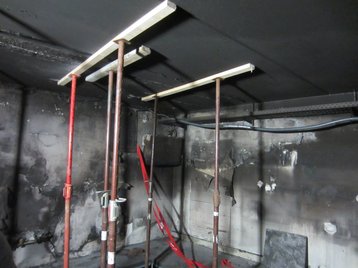Who wants to sell container data centers? Vendors are shying away from the term, preferring the word “modular”. But there’s a lot to be said for the idea of putting servers in boxes.
We started the week at Datacenter Dynamics with a graphic example of the benefits of keeping servers locked inside secure containers. We heard of a data center in Denmark where the IT kit, housed in a modular “IT room”, survived an arson attack which left the rest of the building as a blackened shell.
It’s a terrific story - and one made all the better by the pictures, which contrast the devastation outside the room with the still-shiny servers inside. Once the fire investigation was over, the company could start up its data center, simply by running new power and network cables into the room, to replace the ones that had burnt away.
These weren’t ordinary modules - they were constructed to stand up to rough treatment. But the story clearly illustrates some of the benefits of modularity.
Marketing difficulties
Despite this, modular data centers are apparently held back by marketing difficulties. Pre-built data centers are seen as a limited solution to a small set of problems.
Vendors have failed to articulate the potential of pre-fab modular (PFM) methodology, laments a 451 Research report, which says that pre-fab data centers are growing, but not as fast as they might, because they have an image problem. Pre-built data center units are seen as suitable for remote microsites, temporary capacity or quick builds for disaster recovery.
Some people probably remember the first modular data centers, which were put in re-purposed ISO standard shipping containers, to create a data center that could be loaded onto a truck - packed in its own hard shell, like a snail.
These containerized data centers still exist, but nowadays modular products are usually a more subtle creation. They take in units (such as those from Colt or Excool) that are put together to create larger spaces, says 451 analyst Daniel Bizo: “Modularity doesn’t necessitate small enclosed individual modules. Designers are free to create structures of virtually any size.”
And even the data centers in ISO-standard sizes are most likely in newly-designed units with doors in the right places, not repurposed shipping containers,
So it’s not surprising that when Huawei claimed leadership of the containerized data center market (jointly with HP), some of the companies it claimed to have overtaken objected: we do modular, not containers, they said.
The stigma of shipping crates
All of which may be a shame. Modular as a whole is tainted by containers - and the stigma attached to containers is misplaced. Sealed units saved that Danish firm’s bacon, after all.
And even ISO-sized modules, designed for those specific jobs like remote data centers and disaster recovery, are growing up. This week we heard of standard-sized units from Cannon, with quite sophisticated multi-mode Stulz cooling systems mounted on the outside walls, that switch between cooling techniques as appropriate.
A module can be a lot more than a container, it seems, and there’s more to a container than a tin can.
A version of this post appeared on Green Data Center News.



